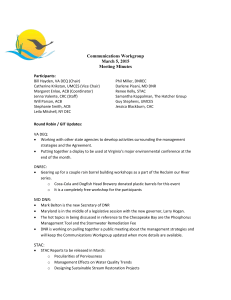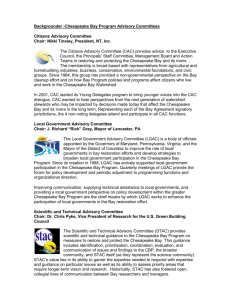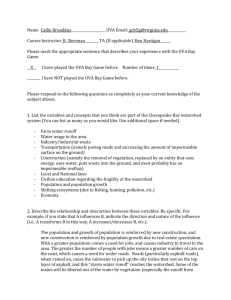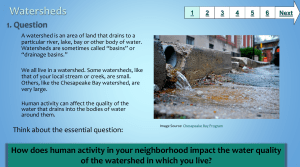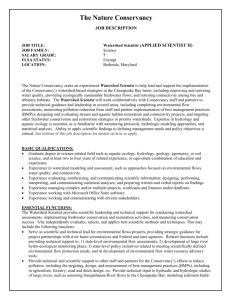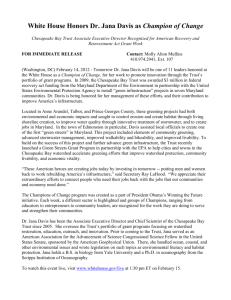Jim Edward Bay Agreement C2K Keystone Commitments
advertisement
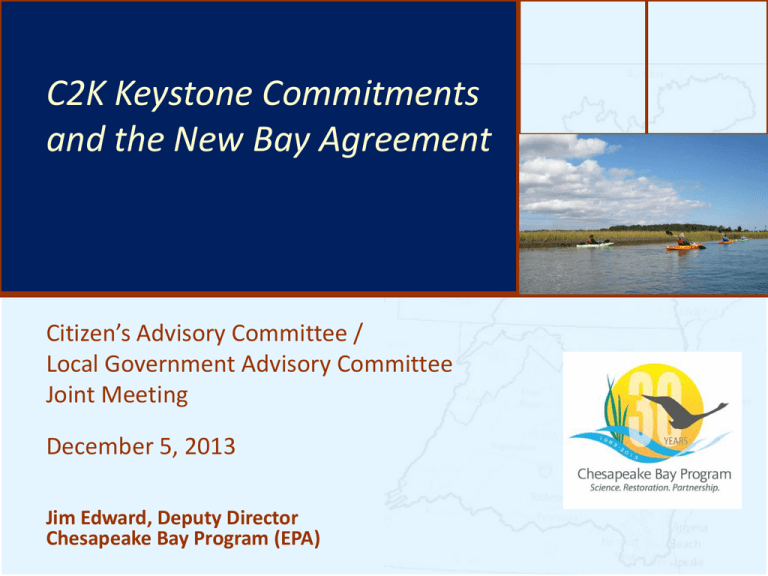
C2K Keystone Commitments The Bay’s Future: How it’s and theHealth New&Bay Agreement doing and What’s Next Citizen’s Advisory Committee / Local Government Advisory Committee Joint Meeting December 5, 2013 Jim Edward, Deputy Director Chesapeake Bay Program (EPA) C2K By the Numbers Living Resourc es Habitat Water Quality Sound Land Use Stewardship Goals 1 1 1 1 1 5 Topics 5 4 5 4 4 22 Commitments Met/Not Met 11(14) 10 / 2 15(18) 8/3 11(20) 8/5 26(28) 7/3 20(22) 7/2 82(102) 40 / 15 -With dates* 11(13) 10(12) 8(13) 15 10 55(60) -With Measures Met/Not Met 2 5 3 6 1 17 1/1 1/3 0 /3 3/3 0 /1 5 /9 * All but one date in Chesapeake 2000 expire on or before 2010 Total Living Resource Protection and Restoration Oysters Commitment By 2010, achieve, at a minimum, a tenfold increase in native oysters in the Chesapeake Bay, based upon a 1994 baseline. Status 10% of goal achieved as of 2008. No longer updated. Latest Draft of New Agreement (11/8/13) Restore native oyster habitat and populations in 10 tributaries out of 35 to 40 candidate tributaries by 2025. Living Resource Protection and Restoration Multi-species Management Commitment Status By 2007, revise and implement existing fisheries management plans to incorporate ecological, social and economic considerations, multi-species fisheries management and ecosystem approaches. 51% of goal achieved as of 2009. No longer updated. Latest Draft of New Agreement (11/8/13) Includes new outcome for forage fish and fisheries habitat. Vital Habitat Protection and Restoration SAV Commitment By 2002, implement a strategy to accelerate protection and restoration of SAV beds in areas of critical importance to the Bay’s living resources. Achieve 185,000 acres of SAV Baywide by 2010. Status 26% of 185,000-acre goal achieved as of 2012. Latest Draft of New Agreement (11/8/13) Maintain 185,000 acre outcome with goal of 90,000 acres by 2017 and 130,000 acres by 2025. Vital Habitat Protection and Restoration Watersheds Commitment By 2010, work with local governments, community groups and watershed organizations to develop and implement locally supported watershed management plans in twothirds of the Bay watershed covered by this Agreement. Status 62% of goal achieved as of 2010. No longer updated. Latest Draft of New Agreement (11/8/13) New outcome - By 2025, 100% of current healthy watersheds remain healthy. Vital Habitat Protection and Restoration Wetlands Commitment By 2010, achieve a net resource gain by restoring 25,000 acres of tidal and non-tidal wetlands. Maintain an average restoration rate of 2,500 acres/year. Status 54% of goal achieved as of 2010. Began tracking EO outcome in 2010: 5,503 acres of wetlands restored 2010-2012* *only includes efforts on agricultural land Latest Draft of New Agreement (11/8/13) New outcome to create or reestablish 85,000 acres of tidal and nontidal wetlands and enhance 150,000 acres by 2025. Vital Habitat Protection and Restoration Forests Commitment Conserve existing forests along all streams and shorelines. Status Ongoing Latest Draft of New Agreement (11/8/13) Added new outcomes for forest buffers and urban tree canopy. Water Quality Protection and Restoration Nutrients and Sediments Commitment Status By 2010, correct the nutrient – and sediment – related problems in the Chesapeake Bay and its tidal tributaries sufficiently to remove the Bay and tidal portions of its tributaries from the list of impaired waters under the Clean Water Act. 29% of goal achieved as of 2012 (Bay segments meeting WQ standards for designated uses) Latest Draft of New Agreement (11/8/13) Added the 2017 and 2025 WIP outcomes from 2010 Bay TMDL. Sound Land Use Land Conservation Commitment Status Strengthen programs for land acquisition and preservation within each state that are supported by funding and target the most valued lands for protection. Permanently preserve from development 20% of the land area in the watershed by 2010. 100% of preservation goal achieved in 2007 Began tracking EO outcome: 8 million acres permanently protected through 2011 Latest Draft of New Agreement (11/8/13) New outcome – By 2025, protect an additional two million acres throughout the watershed. Sound Land Use Development, Redevelopment and Revitalization Commitment By 2012, reduce the rate of harmful sprawl development of forest and agricultural land in the Chesapeake Bay watershed by 30% measured as an average over five years from the baseline of 1992-1997. Status Not able to agree on how to measure Latest Draft of New Agreement (11/8/13) Added two outcomes for Land Use Methods and Metrics (2015) and Use Options Evaluation (2017). Stewardship and Community Engagement Education and Outreach Commitment Beginning with the class of 2005, provide meaningful Bay or stream outdoor experience for every school student in the watershed before graduation from high school. Status 80% of goal achieved as of 2010 Latest Draft of New Agreement (11/8/13) Add goal and three outcomes for meaningful experiences, schools and school systems models, and environmental literacy metrics (2014). CAC Issues Raised to EC 1. 2. 3. 4. 5. 6. Governance Accountability Environmental Literacy Toxic Contaminants Climate Change Conowingo Dam How are they addressed in the Draft Agreement (11/8/13)? CAC Issue 1 - Governance Current Full Draft 11/8/13 Goals and Outcomes Introduction: Except for those outcomes required by law and related to the implementation of the Chesapeake Bay Total Maximum Daily Load (TMDL) under the water quality goal, each signatory may exercise its discretion to participate in the development and implementation of individual outcomes’ management strategies depending upon relevance, resources, priorities, or other factors. Partnerships with other agencies, organizations, and stakeholders will be identified as appropriate. Signatories may decide to adjust their level of participation in the implementation of strategies as circumstances warrant. CAC Issue 1 - Governance Current Full Draft 11/8/13 Management Strategies Development and Implementation: Within one year of the Agreement, Goal Implementation Teams will develop management strategies for the outcomes supporting the Agreement goals. Goal Implementation Teams will reevaluate biennially and update strategies as necessary, with attention to changing environmental and economic conditions. CAC Issue 2 - Accountability Current Full Draft 11/8/13 Preamble: Watershed restoration and protection efforts have shown that measurable results coupled with firm accountability yield the most significant results… The Partnership is committed to improving verification and transparency of its actions to strengthen and increase public confidence in its efforts. Principles: The Partnership will: Operate with transparency in program decisions, policies, actions and progress to strengthen public confidence in our efforts. CAC Issue 2 - Accountability Current Full Draft 11/8/13 Management Strategies Development and Implementation: The Chesapeake Bay Program will make these strategies and reports on progress available to the public in a transparent manner on its websites and through public meetings of the appropriate Goal Implementation Teams and Management Board. CAC Issue 3 - Environmental Literacy Current Full Draft 11/8/13 Environmental Literacy Goal: Enable students in the region to graduate with the knowledge to use scientific evidence and citizenship skills to act responsibly to protect and restore their local watershed. Meaningful Watershed Educational Experience Outcome: Increase the number of students participating in teachersupported meaningful watershed educational experiences in elementary, middle and high school. CAC Issue 3 - Environmental Literacy Current Full Draft 11/8/13 School and School System Model Development Outcome: The Partnership will support and highlight models of sustainable schools and local education agencies that use system-wide approaches for environmental education. Environmental Literacy Metrics Outcome: By 2014, develop baseline metrics to establish and measure outcomes related to student participation in teacher supported meaningful watershed educational experiences and related activities. CAC Issue 4 - Toxic Contaminants Language considered, but rejected: Toxic Contaminants Research Outcome: Assess planned research and opportunities for new research to improve knowledge of the effects of contaminants of emerging concern on the health of fish and wildlife by 2015 so future strategies can be considered. Toxic Contaminants Reduction Outcome: Identify practices and an implementation schedule by 2015 to reduce loadings of PCBs and mercury to the Chesapeake Bay and its watershed. CAC Issue 4 - Toxic Contaminants Rationale While several partners supported inclusion of toxic contaminant outcomes, some expressed concerns related to whether there is a need for the CBP to apply itself to contaminant issues that are the target of established impairments and, in some cases, local TMDLs in the jurisdictions. Jurisdictions felt that toxic contaminants are being addressed already through state programs and local TMDLs for contaminants. Other arguments against including the reduction outcomes, such as the contaminants of concern are not transported across state boundaries and the contaminants are bound in legacy sediment only with no ongoing inputs, were influential but are not necessarily substantiated in the technical literature. CAC Issue 5 - Climate Change Current Full Draft 11/8/13 Preamble: Much progress has been made, but there is more to do especially in the face of continued challenges such as changes in population, loss of farm and forest lands and changing environmental conditions. Principles: The Partners will: Anticipate changing conditions, including long-term trends in sea level, temperature, precipitation, land use and other variables. CAC Issue 5 - Climate Change Current Full Draft 11/8/13 Management Strategy Development and Implementation: Management strategies may address multiple outcomes if deemed appropriate. Goal Implementation Teams will reevaluate biennially and update them as necessary, with attention to changing environmental and economic conditions. Policy changes to address these conditions and minimize obstacles to achieve the outcome may be identified. CAC Issue 5 - Climate Change Rationale “Climate change” should not be included as a goal or outcome, but adapting to “changing environmental conditions” will be included as a cross-cutting issue to be addressed in the Management Strategies for outcomes because it is a factor influencing the Partnership’s ability to meet goals and outcomes. CAC Issue 6 - Conowingo Dam Current Full Draft 11/8/13 Excluded Rationale Specific mention of the Conowingo Dam is not at the scale or level of detail appropriate for this Agreement. It is being addressed by various studies that EPA and the jurisdictions participate in, including those of the Lower Susquehanna River Sediment Task Force, the Army Corps of Engineers, and the EIS study by the Federal Energy Regulatory Commission. LGAC Issues Raised to EC Fully supports current local government language in the Draft Agreement (11/8/13). 1. 2. 3. Funding Inadequate Improve Communications Headwater states representation on Advisory Committee LGAC Issues - Local Leadership Current Full Draft 11/8/13 Preamble: One of the most important lessons learned from the past three decades is that, while watershed-wide partnerships help to coordinate and catalyze, implementation happens locally. Local governments are key partners as are individual citizens, businesses, watershed groups and other nongovernmental organizations. Working together to engage, empower and facilitate these partners will leverage resources and ensure better outcomes. LGAC Issues - Local Leadership Current Full Draft 11/8/13 Principles: The Partnership will: Acknowledge, support and embrace local governments and other local entities in watershed restoration and protection activities. Use place-based approaches, where appropriate, that produce recognizable benefits to local communities while contributing to larger ecosystem goals. LGAC Issues - Local Leadership Current Full Draft 11/8/13 Goals and Outcomes Introduction: Local government will continue to play a unique and critical role in helping the Partnership realize the shared vision for the Chesapeake Bay. Management Strategies: Where appropriate, management strategies should describe how local governments, nonprofit and private partners will be engaged; where actions, tools or technical support are needed to empower local governments and others to do their part; and, what steps will be taken to facilitate greater local participation in achieving the outcomes. Chesapeake Bay Watershed Agreement Development Timeline Chesapeake Bay Watershed Agreement Development Timeline (Cont’d.) Jan.
